History in dates

An art record of a company Wichlerle & Kovářík, the area of the car maker was down on the left
The establishment of a car maker Wikov and its family tree
A car department, later called a car maker Wikov, was established at the beginning of the year 1924 as a part of a the then company Prostějov factory for a machine production Wichterle & Kovářík, a joint-stock company. This company came into existence of fusion companies F. Wichterle (est. 1878) and F & J. Kovářík (est. 1894) which were placed in Prostějov as well. They had almost identical producing program (apart from a threshing machine, locomotive and steam even petrol and diesel engines) and they competed with each other. This fusion was accepted in a negotiation at general meeting of the company F. & J. Kovářík, a joint-stock company which was held 22 December 1918 at National House in Prostějov with the participation of owners of the F. Wichterle´s company. In the 1920s, Wichterle & Kovářík expanded its original producing program not only to produce cars but also to three-phase electro motors and tractors.
A proposal for an installation of cars production
The establishment of the car maker was preceded by a proposal for the development and a production of a popular car which was put forward 27 October 1923 by Dr. Ing. František Kovářík in a technical report, presented at an extraordinary meeting of a board of directors of the company Wichterle & Kovářík. As the main reason for the installation of this production, Dr. Ing. Kovářík mentioned higher employment and an option of a series production because of the awaited motorization development in pre-war Czechoslovakia. At the same time, he recommended an advancement of the development which required to accept an experienced design engineer, also its own development of a completely new vehicle, which corresponds with all the technical and scientific possibilities that time.

Dr. Ing. František Kovářík, the co-owner of the Wichterle & Kovářík´s company. The first Czech doctor of technical science at VUT in Brno.

Lambert Wichterle, the co-owner of the Wichterle & Kovářík´s company and the chairman its board of directors.
A production premise, management and employees of the car maker
In 1924, the first set aside Wichterle´s factory was built from 1882 to 1883 for a car production, at the time of the beginning of development F. Wichterle´s company. A workshop engineer and bodywork master were accepted. Also, it was decided to produce bodywork for foreign chassis and repairing cars. A body shop, motor brake and workshops for series assembly engines, chassis and completing of the whole vehicles were built step by step in the premise of a factory. Management of the car maker were authorized Ing. František Kovářík, the son of Ing. Josef Kovářík and Eugen Wichterle, Lamberta Wichterle´s son. In this car maker, the most qualified technical experts and labourers were employed from a parent company. At the time of the biggest development, 21 technical experts (masters included) and 160 labourers were working there.

Management of the car maker. A photo from the years around 1930.
Eugen Wichterle – sitting on the left, Ing. Boleslav Hazelka – chief designer, Ing. František Kovářík, Ing. Josef Kovářík – a son
The development of a new vehicle
Structural works of the new vehicle were opened by the beginning of 1924, after received purchased chassis of an Italy vehicle Ansaldo which was a structural model in a development of a passenger vehicle. The development began progressively. From the small vehicle, originally with a content of an engine cylinder up to 1 litre but later they increased the amount to 1,25 and 1,35 litres up to medium-sized, more efficient, better equipped and more expensive vehicle with the content to 1,5 litres. In 1924, 5 vehicles 4/16 HP (1,25 litres) were developed and produced in spring in 1925. At the end of 1925, 15 vehicles 5/20 HP (1,35 litres) were produced. During the development and a tests of the vehicles up to 1,35 litres, the management of the company decided after discussions and an economical balance sheet for a development and a small series production of the vehicles up to 1,5 litres for exacting and wealthy clients.
Completion of development and opening a production of a vehicle 7/28
An excellent and experienced designer Ing. Boleslav Hanzelka was nominated as a chief designer of a car department who started in Tatra Kopřivnice in 1914. Under his management, the development of the vehicle 1,5 litre was finished. At the end of 1927, his small series production started – type marked with 7/28 was opened.

A car Wikov 7/28 faeton, one of the first version of the Wikov´s cars
Progress and downfall of the car maker Wikov
The car Wikov 7/28 was a basic type. Lots of modifications were quickly derived from the car Wikov 7/28 and became an initial basis for the development and production of vehicles with the engine content 1,75 litres and 2 litres, those were vehicles Wikov 35, Wikov 40 and its relative utility and lorries. Although the car maker Wikov was technically very successful, the good name with a long-time tradition was missing. As a result of this commercially important circumstance, with a relatively high price of the vehicles and the then small effective demand, it was for a long time economically unprofitable. Therefore, in 1937, the production and an assembly of the passenger cars were completely stopped. After finishing military orders for production of lorries Wikov 1,5 t from 1936, the production of the car maker was definitively discontinued in 1940. In the next years, till a nationalization in 1945, there was a repair shop of passenger and foreign cars in the car maker.
Fragments from history of the Wichterle & Kovářík company
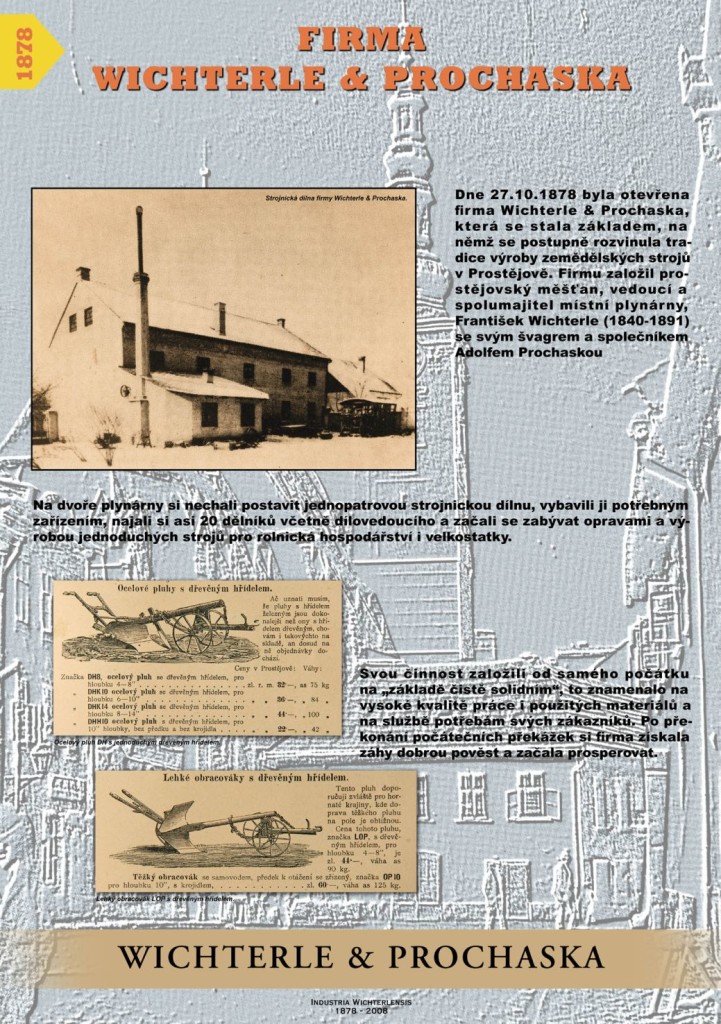
1878 A COMPANY
WICHTERLE & PROCHASKA
Wichterle & Prochaska company was opened 27 October 1878. It became a basis where later a tradition of an agricultural machines was developed in Prostějov. The company was established by a burgess from Prostějov, a manager and a co-owner of a local gasworks – František Wichterle (1840-1891) with his brother-in-law and a business partner Adolf Prochaska.
In the yard of the gasworks, they have two-floor engineering workshop built. They equipped it with needed devices, hired approximately 20 labourers, a foreman included. They started to be interested in repairs and production of simple machines for an agrarian economy and large farms.
They established its business from the beginning based on “purely solid”, it meant a high quality of a work and used materials and on service needs of their customers. After overcoming the initial obstacles, the company gained a good name and started prospering.
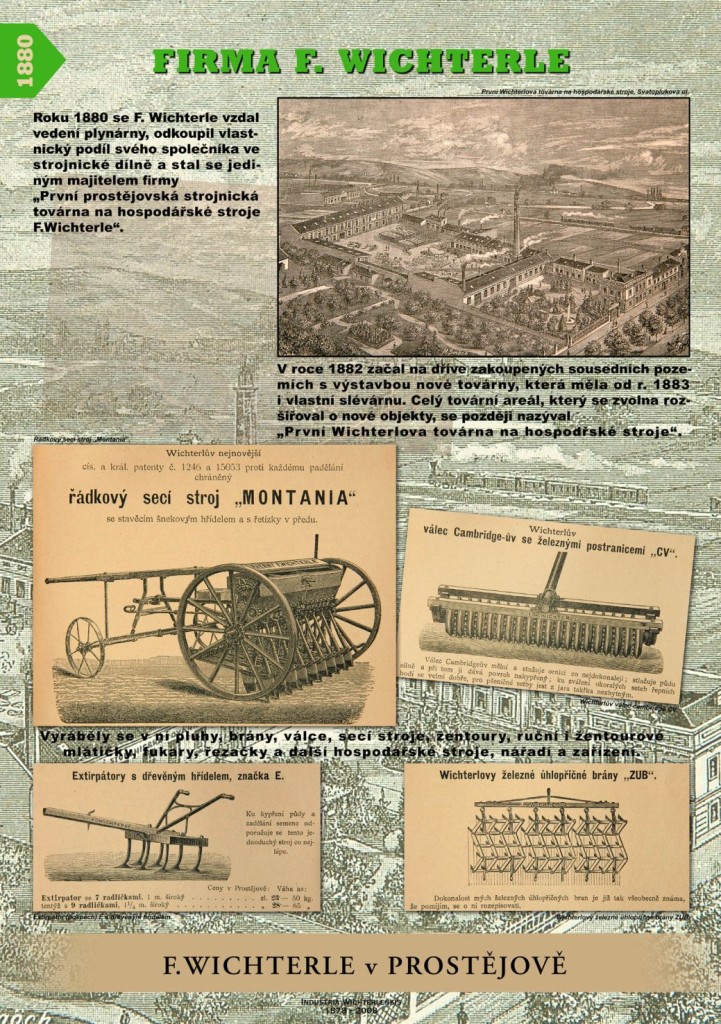
1880 The company F. WICHTERLE
F. Wichterle gave up managing gasworks in 1880, he bought share of his associate in an engineering workshop and became the only owner of the company “The first Prostějov engineering factory producing agricultural machines F. Wichterle.
He started building new factories on an earlier bought lands in 1882 which had also their own foundry from 1883. The whole area which was continuously widened with new buildings was later called “The first Wichterle´s factory producing agricultural machines.
Ploughs, harrow, cylinders, seed drills, threshing machines, cutters and other agricultural machines, tools and devices.
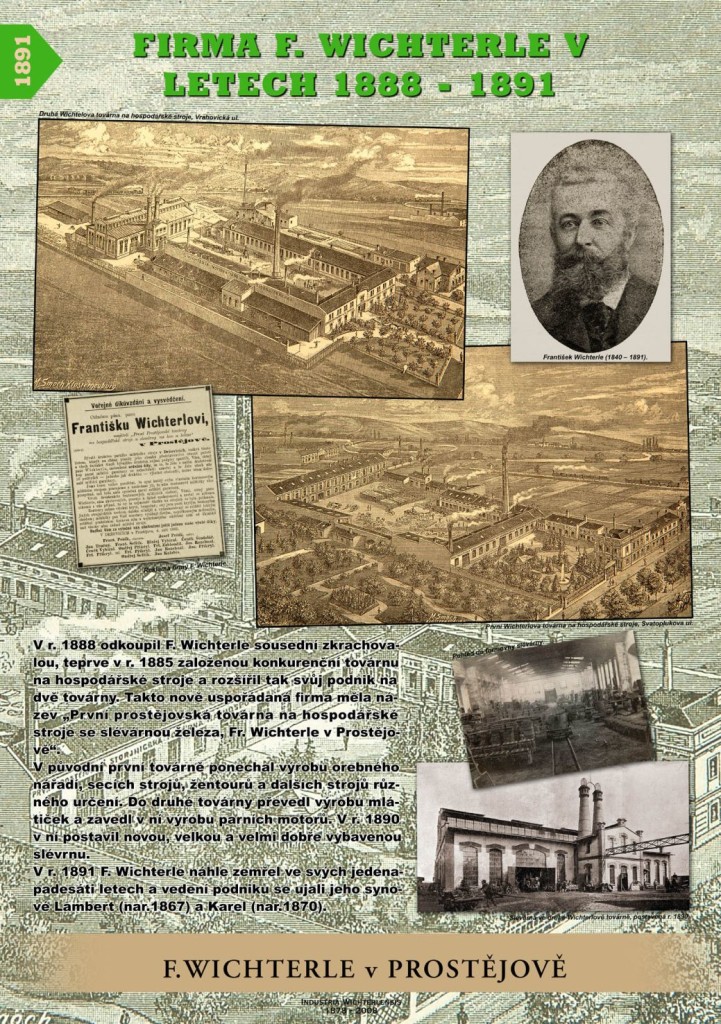
1891 THE COMPANY F. WICHTERLE 1888-1891
F. Wichterle bought a neighbour bankrupt factory in 1888 which was established in 1885 as a competitive company. He enlarged his company for 2 factories. The new company had a name: “The first Prostějov factory producing agricultural machines with ferrous foundry, Fr. Wichterle in Protějov.”
In an original first factory, he gave up producing tools, seed drills and other various things. In the second factory, instead of producing threshing machines, he started to produce steam engine. He built a big new, well equipped foundry in 1890.
When F. Wichterle suddenly died, he was only 51 years old. The management of the company became his sons Lambert (born in 1867) and Karel (born in 1870).
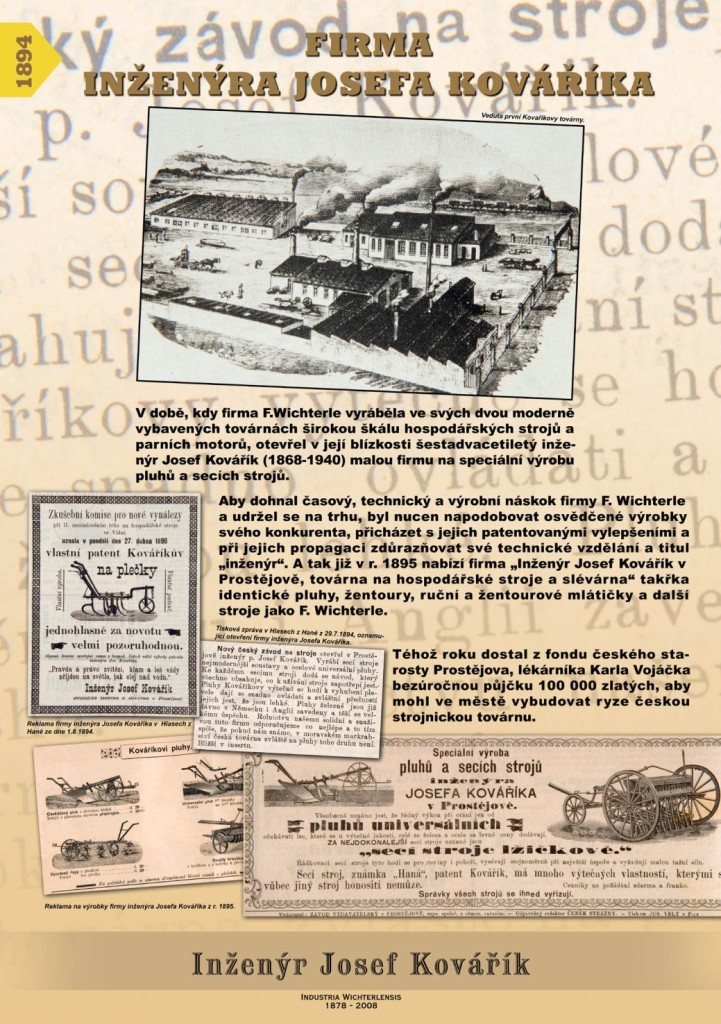
1894 THE COMPANY OF ENGINEER JOSEF KOVÁŘÍK
At times, when the company F. Wichterle was producing in his two modern equipped factories wide variety of agricultural machines and steam engines, an engineer Josef Kovářík was 26 years old, opened a small company not so far from F. Wichterle company and produced special sloughs and seed drills.
So that he caught up with the company of F. Wichterle in terms of time, technique and production and would stay on the market, he was forced to copy proven products of his concurrent, come with their patented improvements and when it comes to the promotion, he had to emphasize his technical education and a degree “engineer”. Therefore, in 1895 the company “Engineer Josef Kovářík in Prostějov, a factory producing agricultural machines and foundry” offers identical ploughs, threshing machines and other machines like F. Wichterle.
At the same year, he got interest-free loan 100 000 bullion coins from a fond of Czech mayor of Prostějov – the pharmacist Karel Vojáček. So that he could build purely Czech agricultural factory in the town.
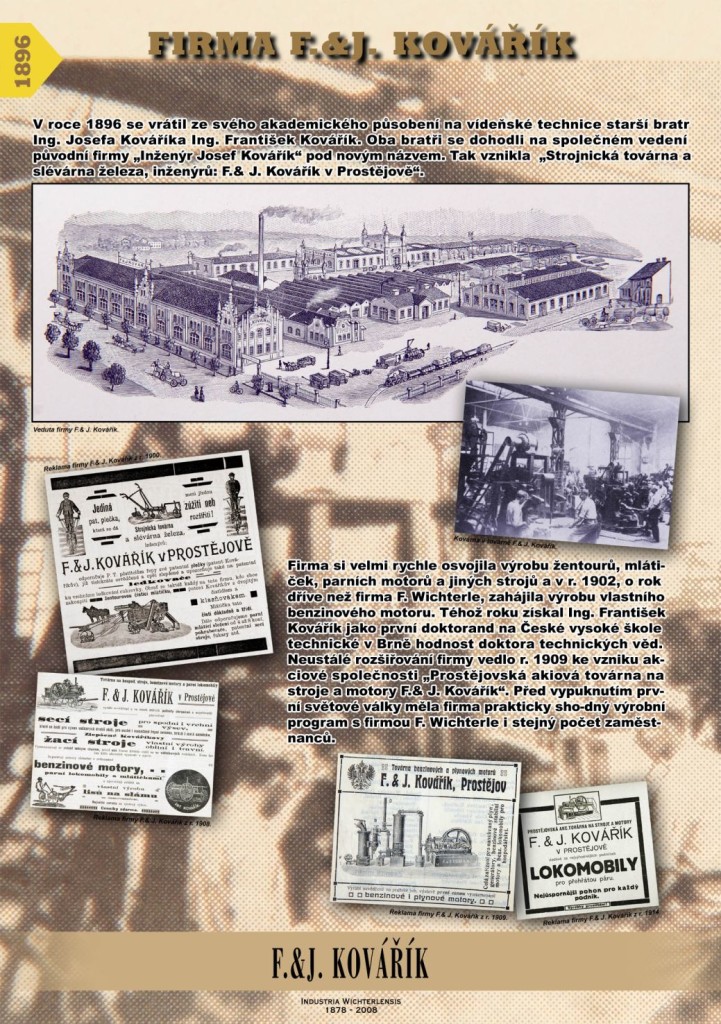
1896 A COMPANY F. & J. KOVÁŘÍK
Ing. Josef Kovářík´s older brother – Ing. František Kovářík came back from his academic work at Viennese technique in 1896. Both brothers agreed on collective management of the original company “Engineer Josek Kovářík” under a new name. So, it was established “Engineering factory and iron foundry of engineers: F&J. Kovářík in Prostějov.
The company adopted very quickly a production of horse mills, threshing machines, steam engines and other machines and in 1902, 1 year earlier than the company F. Wichterle, it started producing their own petrol engine. In the same year, Ing. František Kovářík gained as the first PhD student at ČVUT (Czech Technical University) in Brno an academic degree: Doctor of Technology. A constant expansion of the company led to an establishment of joint-stock company in 1909 “Prostějov joint-stock factory producing machines and engines F&J. Kovářík“. Before the WWI burst out, this company had practically the same manufacturing program as the company F. Wichterle, even they had the same number of employees.
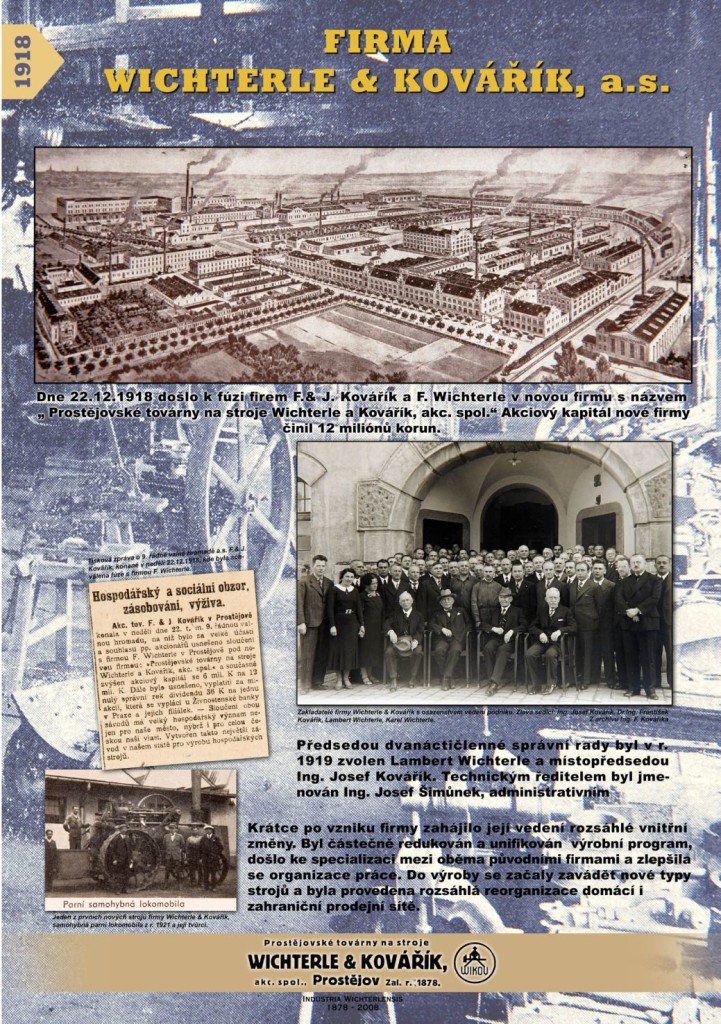
1918 A COMPANY WICHTERLE & KOVÁŘÍK, joint-stock company
22 December 1918 happened a fusion of companies F&J. Kovářík and F. Wichterle with a new company called “Prostějov factories producing machines Wichterle and Kovářík, a joint-stock company.” Share capital of the new company was 12 million CZK.
Lambert Wichterle was chosen as a chairman of 12 members of board of directors in 1919 and Ing. Josef Kovářík was chosen as a deputy chairman. A chief technologist was nominated Ing. Josef Šimůnek in administrative.
Shortly after the establishment of the company, the management has started wide inside changes. A manufacturing program was reduced and unified, there was a specification between the two original companies and a work organization has also improved. New types of machines have been introduced in a production and an extensive reorganisation of domestic and foreign sales network has been accomplished.
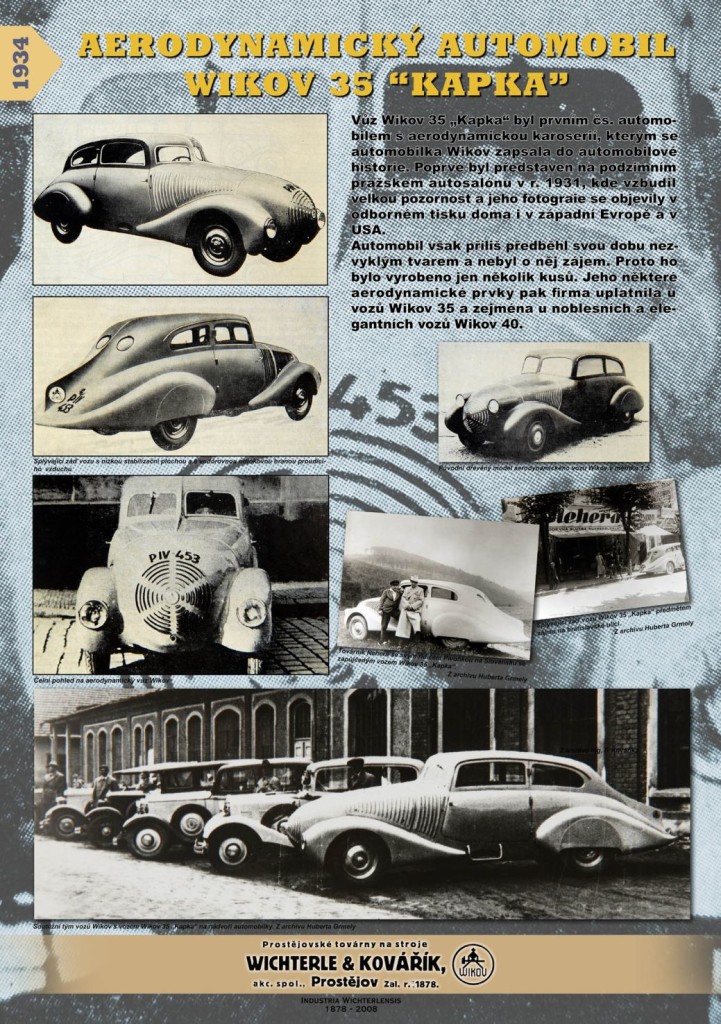
1934 AN AERODYNAMIC VEHICLE WIKOV 35 “KAPKA” (Drop)
The vehicle Wikov 35 “Kapka” (Drop) was the first Czechoslovak vehicles with aerodynamic bodywork. Thanks to the bodywork, a car maker Wikov went down in a car history. For the first time, it was introduced at autumn Prague car showroom in 1931, where aroused a large attention and his photos were published in professional press at home and even in West Europe and in USA.
The vehicle was ahead of the time due to an extraordinary shape and therefore nobody was interested in it. So, just a few pieces were produced. Some of the aerodynamic elements the company used for a vehicle Wikov 35 and especially for graceful and elegant vehicles Wikov 40.
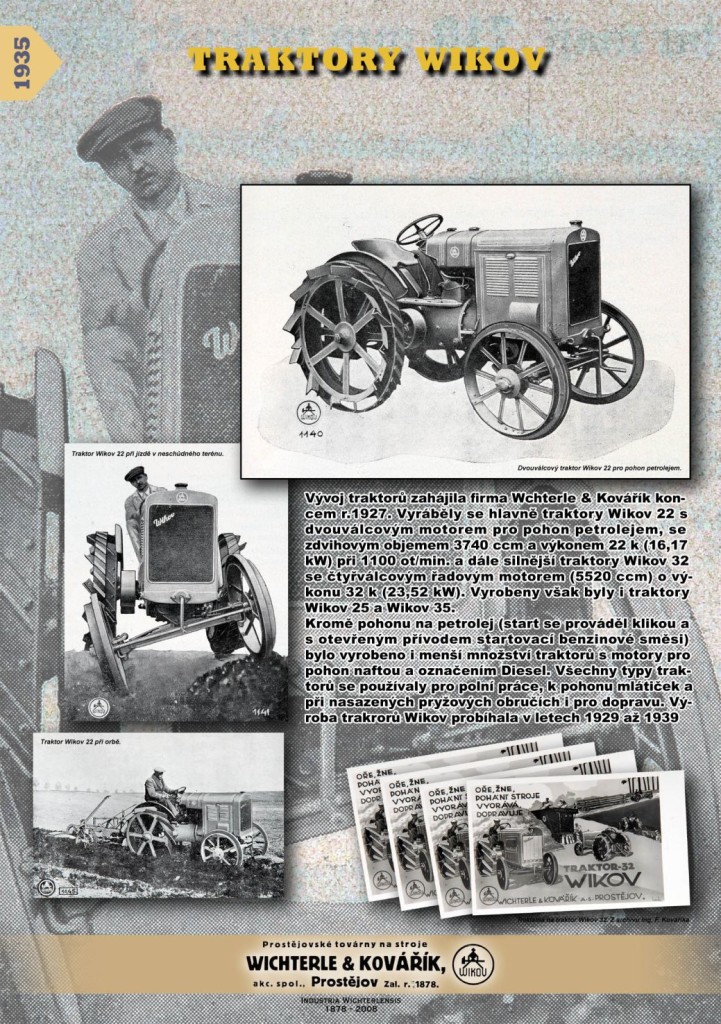
1935 TRACTORS WIKOV
The development of tractors started a company Wichterle & Kovářík at the end of 1927. They were producing mainly tractors Wikov 22 with two-cylinder engine for a drive paraffin oil, cylinder capacity 3740 CCM and power 22k (16,7 kW) during 1100 revs per minute. The next one are stronger tractors Wikov 32 with four-cylinder straight engine (5520 CCM) with a power 32k (23,52 kW). Tractors like Wikov 25 and Wikov 35 were also produced.
Apart from a drive on paraffin oil (the start was carried out by a crank handle and opened supply of the starting petrol mixture), there were produced even a smaller number of tractors with diesel engines and marker with Diesel. All types of the tractors were used for working on a field, for a drive of threshing machines and during placing rubber rings even for transport. The production of the tractors Wikov was going on between 1929 and 1939.
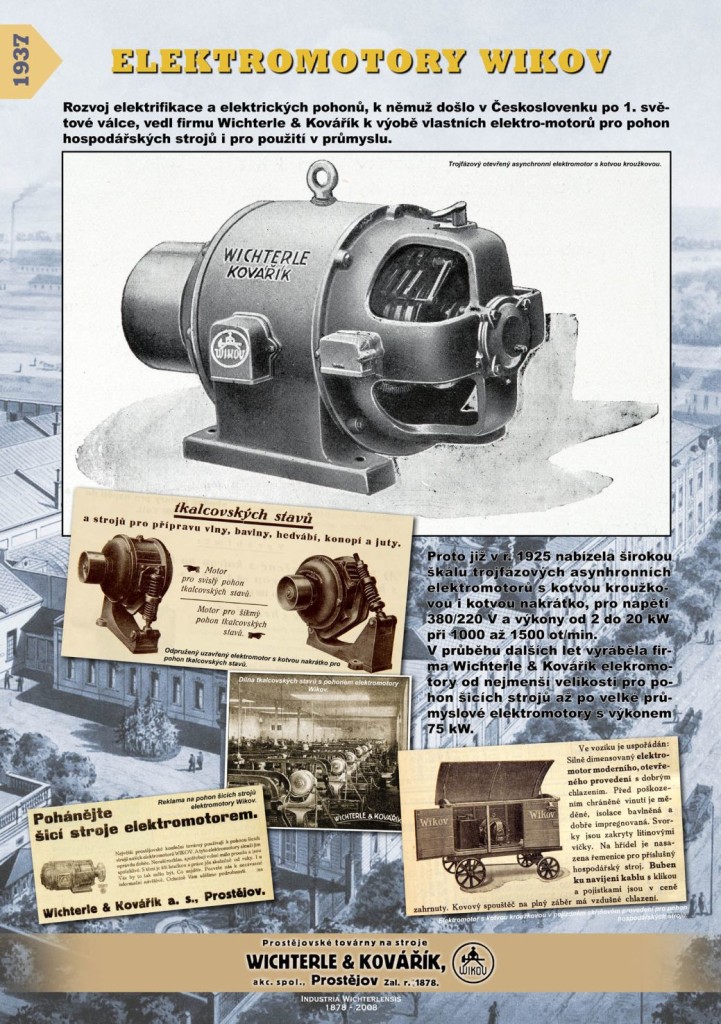
1937 ELECTRIC MOTORS WIKOV
The development of electrification and electric motors, that happened after WWI in Czechoslovak, Wichterle & Kovářik led the company to a production of their own electric motors for a drive of agricultural machines, even for a use in an industry.